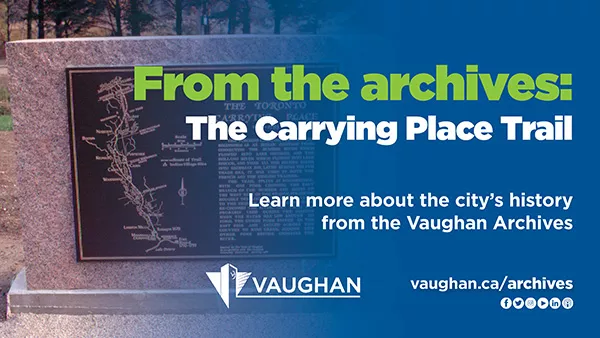From the archives: The Carrying Place Trail
Learn more about the
city’s history from the Vaughan Archives
From the traditional territories of the First Peoples of Turtle
Island, to a farmland community, to a bustling city centre and everything in
between – Vaughan’s transformation is a story worth telling. As part of a
monthly series, the City of Vaughan is releasing historical content from the
Vaughan Archives, Office of the City Clerk. Citizens are encouraged to scroll
through memory lane, learn about the city’s past and explore the places, people
and events that were pivotal to the development of the city of Vaughan we know today.
The Carrying Place
Trail is
the next feature in this archival series. It was a major portage route which
linked Lake Ontario to Lake Simcoe by way of the Humber and Holland River systems.
It was also known as the “Humber Portage” or the “Toronto Passage,” a name that
comes from the Mohawk term “Tkaranto,” meaning “the place where there are trees
standing in water.” It consisted of one long portage at 45 kilometres in
length, instead of several short ones. The route was challenging as the banks
were swampy and wooded, but the trail cut the total journey down by hundreds of
kilometres as users no longer had to travel around the Great Lakes to reach the
Toronto area.
The trail was used for
trade as early as 1500, and portaging often proved necessary because the low
waters of the Humber were difficult to traverse. These passages were regularly
clogged with fallen logs and beaver dams. Also, in winter, the Humber River
(also known as Cobechenonk and GabeKanang Ziibi) froze, and the steep banks
offered little defence against attack, making anyone who used these routes
vulnerable.
The Carrying Place
Trail was primarily used by First Nations communites, including the
Huron-Wendat tribe, which controlled the area until 1649 when it passed to the
Haudenosaunee. In 1685, the territory was transferred to the Mississaugas of
the Credit First Nation, with whom the City holds Treaty 13 and upon whose
territory the city of Vaughan was built. Treaty 13 was signed in 1805 to clarify
an earlier contested treaty, which had the Humber River (which the Carrying
Place Trail follows) as a boundary. In addition to Indigenous Peoples, the
French and British also used the route for trading and it contributed to the
British development of York (present-day Toronto).
The Carrying Place
Trail followed the east bank of the Humber River until it reached the Pine
Grove area in the city of Vaughan. At this point, the route split, with one
fork running parallel to present-day Islington Avenue along the west side of
the East Humber River to Kleinburg, where it re-crossed the waterway. The other
fork on the trail followed the east shore of the East Humber, rejoining the
first fork above King Creek. The trail crossed the Humber River again near
Nobleton, before rambling northward through open country to a tributary of the
Holland River (also known as Micicaquean Creek).
ABOUT VAUGHAN ARCHIVES
Established in 1988,
the City of Vaughan
Archives
is home to more than 600 collections, consisting of both City records and cultural
records about Vaughan from 1860 to present day. Records include, but are not
limited to, the following:
- City business records with long-term legal and administrative value, such as Council meeting minutes, by-laws, assessment rolls, financial records, reports and official correspondence
- church, community and school records
- census records
- historical photographs
- land records
- historical maps, plans and aerial photographs
- newspapers
- personal papers of past residents and founding families, such as diaries, family histories, journals and letters
- records of local organizations both past and present
VIEW VAUGHAN’S ARCHIVES
ONLINE!
As part of the City's
COVID-19 response, Vaughan City Hall remains closed to the public – but the
City’s Archival Collection is on digital display for all to explore! The below
galleries are now available in the City’s online gallery on Flickr:
- Featured Artists of Vaughan
- Historical Families of Vaughan
- Historical Figures: Lord Beaverbrook
- Historical Photography
- Recollections of Rural Vaughan
- The Mary Wood Collection
- The Way We Were: Representations of Vaughan’s Past
- Vaughan Working Environments
- Vaughan Through the Ages: Medicine
- Vaughan Through the Ages: Music
- Vaughan Through the Ages: Sports and Recreation
A
personal Flickr account is not required to access the City’s online gallery,
which contains only a small selection of the full archives collection. If you
are looking for a certain image, original file, primary source record or more, contact
the Vaughan Archives by calling 905-832-2281 or emailing archives@vaughan.ca.
By managing and
preserving both City and community records, the Archives and Records Management
Services team ensures that Vaughan’s rich and varied history will continue to
be available for future generations. Learn more at vaughan.ca/archives.
-30-

